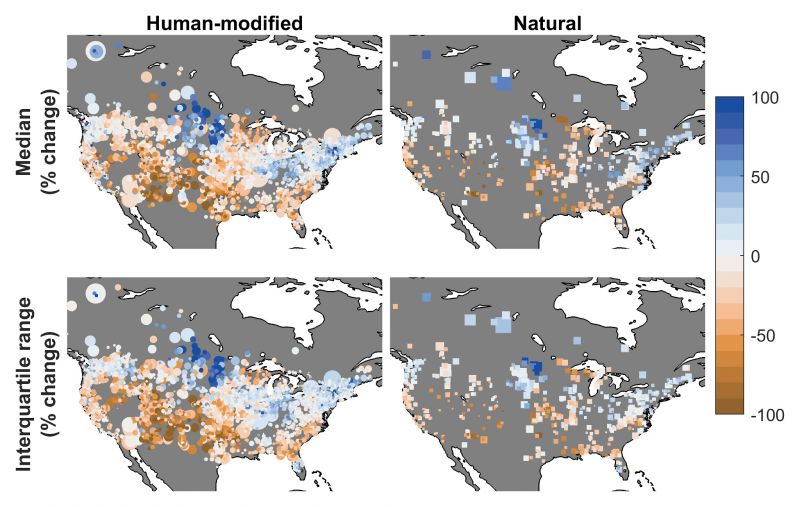Managed Waterways Are Not Isolated From Effects of Climate Change
Published on by Water Network Research, Official research team of The Water Network in Academic
A new study led by researchers at Indiana University has found that modifications such as dams and reservoirs do not isolate rivers and streams in the United States and Canada from the effects of climate change.
By Kevin Fryling

These maps show two measurements of streamflow changes in natural and human-modified waterways across the U.S. from 1981 to 2015, with bluer areas indicating increases in water flow and browner areas indicating decreases in water flow. Source: Indiana University
The analysis published Aug. 6 in the Proceedings of the National Academy of Sciences shows that the flow of water in managed waterways has diminished in the southern and western United States over the past three decades in the same manner as waterways in these regions without modifications.
Similarly, the study also found that the flow of water in the rivers and stream of the northeastern United States, as well as in the northern Great Plains and southern prairies of Canada, has grown stronger over the past 30 years -- the same as natural waterways in these regions.
"This study finds that large-scale climate trends are already affecting water availability in many regions of the southern and western United States," said Darren Ficklin, an associate professor in the IU Bloomington College of Arts and Sciences Department of Geography and a member of the Environmental Resilience Institute at IU, a part of the university's Prepared for Environmental Change Grand Challenge. "This is significant given the importance of streams and rivers for agricultural use, urban drinking water and aquatic ecosystems in these regions."
The study is the first analysis to provide an in-depth look at the effect of climate change on managed waterways in the U.S. and Canada as compared to unmanaged streams and rivers. Traditional research on the effects of climate change on waterways focused on unmanaged -- or "natural" -- streams and rivers, as water-management techniques were thought to obscure "climate signals" in research.
To conduct the study, Ficklin and colleagues analyzed data on over 3,000 North American rivers and streams between 1981 and 2015 from the U.S. Geological Survey and the Canadian Department of the Environment. Of these waterways, 2,549 were considered managed resources. Only 570 waterways were considered natural -- or about two out of every nine waterways in these countries.
A similar proportion of managed and natural waterways exists across the globe, Ficklin said. The ability to use these streams and rivers in climate research would open up many regions to observations about how changes in weather patterns, temperature and rainfall affect water access and supply.
"We believe that many, many more waterways could be used for climate research," he added. "While certain characteristics like peak and low streamflow may still differ significantly, we find that the recent trends are quite similar."
The study also sheds light on the relatively small impact that water management has on large-scale changes in climate trends.
"Generally, managed watersheds only mitigate the effects of climate change in extremely dry periods," said study co-author Sarah Null of Utah State University. "For the other 99 percent of streamflows, these results suggest that current water management does not counteract the effects of climate change. This would require more innovative and strategic water management methods."
The work doesn't necessarily mean that the current water management methods are ineffective, Ficklin added. But it does suggest that the "signal" of climate change is apparent in typical flows across all waterways, no matter how they're managed. After a certain point, he said, water management is simply unlikely to provide a solution to large-scale changes in water availability.
"What this means for people in drying areas is that water management is not resulting in 'more water' for agricultural, environmental and urban purposes," he said. "People in drying areas simply have an increasingly limited amount of water to use. Ultimately, water management methods can't simply change that."
Prepared for Environmental Change, the second of Indiana University's Grand Challenges initiatives, brings together a broad, bipartisan coalition of government, business, nonprofit and community leaders to help Indiana better prepare for the challenges that environmental change brings to our economy, health and livelihood.
Additional authors on the study are Scott M. Robeson of the IU Department of Geography, John T. Abatzoglou of the University of Idaho and Jason H. Knouft of Saint Louis University. This work was supported in part by the National Science Foundation.
Source: Indiana University
Media
Taxonomy
- Resource Management
- Water Resource Management
- Climate Induced Hazard
- River Studies
- Climate Change
- Natural Resource Management
- Climate Change Adaptation
- River Restoration
- Climate Change Resilience
- Water Resource Management